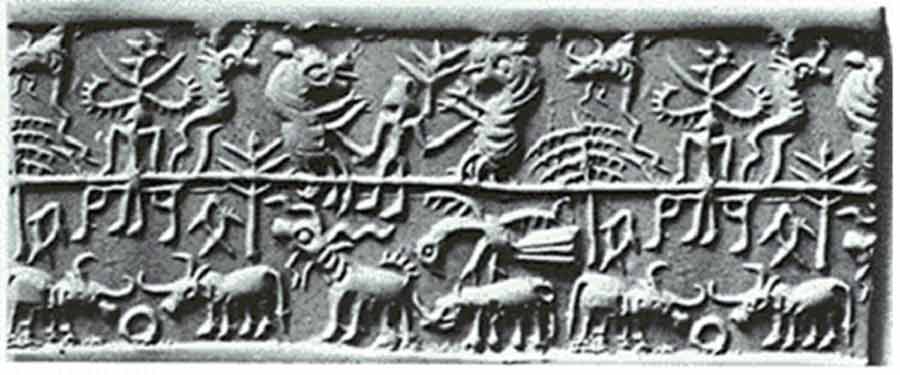
Indus Valley seal
Editor’s Note:
Prof. Asko Parpola is a Finnish Indologist and Sindhologist, current professor emeritus of Indology and South Asian Studies at the University of Helsinki.
Generally recognized as the world's expert on the Indus script, Asko Parpola has been studying this undeciphered writing for over 40 years at the
University of Helsinki in Finland. He is co-editor of collections of all seals and inscriptions in India and Pakistan.
As Professor of Indology he has led a Finnish team of experts through numerous approaches to the puzzle of one of the world's very earliest writing
systems. A grand summary of Dr. Parpola's work, Deciphering the Indus Script was published by Cambridge University Press in 1994. His next opus, The Roots of Hinduism: The Early Aryans and the Indus Civilization, was published by Oxford University Press in 2015.
In this article Prof.Parpola engages in a wide ranging discussion with Vikram Zutshi, Dr. Debashish Banerji and Dr. Jeffery Long on several fascinating
topics related to his ouevre.
Vikram Zutshi:
Describe the premise of your book The Roots of Hinduism. What can a reader expect to take away from this work? How do you define Hinduism and
where can its roots be found?
Asko Parpola:
The earliest literature of South Asia, generally dated between about 1300 and 1000 BCE, consists of the hymns of the Rigveda. In these skilfully
constructed poems, people calling themselves Ārya praise their deities and pray for victory in battle, for sons, and for other good things. What is the
prehistoric background of these Āryas? Their Sanskrit language belongs to the Indo-European language family mostly spoken outside India. This raises the
question: where are the roots of the Vedic religion? And what is the source of the non-Vedic elements of classical Hinduism, which emerges from 400 BCE
onwards in the great epics Mahābhārata and Rāmāyaṇa and in the numerous Purāṇas? Could they come from the advanced civilization of the Indus Valley that
flourished between about 2600 and 1900 BCE, long before the Vedic texts came into being? The Harappan language and religion and the decipherment of the
long-forgotten Indus script have remained hotly debated problems, but could they be solved, at least partially? These are some of the main issues that I
have tried to clarify during the past fifty years, and the book summarizes the principal results of my study.
Vikram Zutshi:
What are your findings on the origin and formation of Vedic literature and rites? Who compiled the Rig Veda? What are its links with the later Upanishads?
Is there such a thing as a cohesive 'Vedic civilization'?
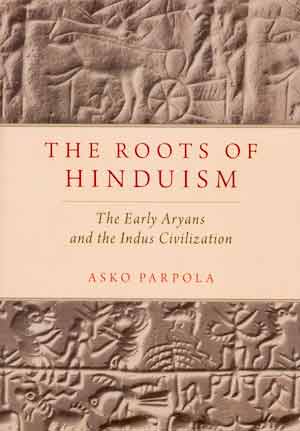
Asko Parpola:
Sorting out the Indian and extra-Indian elements of the Vedic religion requires, first of all, understanding the prehistoric background of the Sanskrit
language in which the Vedic texts have been composed, its relationship with related languages, and tracing its route of immigration with the help of
archaeology, taking the whole of Eurasia into consideration. My conclusion is that the Vedic literature and religion results from the fusion of two major
waves of Indo-Aryan speakers coming from Central Asia to South Asia. The old core of the Rigveda, the hymns of the "family books" II-VII, represent the
tradition of the later wave, which arrived around 1400-1200 BCE, and brought with them the cult of God Indra, worshipped with Soma sacrifice. The tradition
of the earlier wave, coming to South Asia already around 1900-1700 BCE, infiltrated into the Rigveda in its late books I and VIII-X, but is best
represented in the Atharvaveda. By the time the Yajurvedic Samhitās and the Brāhmaṇa texts came into being, the two traditions had already fused together.
The Upaniṣads and the "heterodox" religions of Jainism and Buddhism bring to the surface religious ideas that may be new or that may have survived from
older times further east, outside the Vedic realm.
Jeffery D. Long:
Dr. Parpola, Johannes Bronkhorst postulates a culture in the middle to late first millennium BCE which he calls ‘Greater Magadha,’ to which he attributes
certain key concepts and practices that emerge as Jainism and Buddhism (and other śramaṇa traditions, such as the now-extinct Ājīvikas). Bronkhorst
suggests that this culture is descended from an earlier wave of Indo-Aryan migration, with the “orthodox” Vedic traditions representing a later wave. He
sees the Upaniṣads as an effect of the interaction and integration of these two waves, and of the “orthodox” Vedic culture of the northwest with the
‘Greater Magadha’ culture of the eastern half of the Ganges river valley. Two questions: What do you think of this thesis? And if you are largely in
agreement with it, would you identify the wave of Indo-Aryan migration that you associate with books II-VII of the Rig Veda as an antecedent of the Greater
Magadha culture, and the earlier wave, which you identify with books I and VIII-X and the Atharvaveda as the direct antecedent of the Upaniṣadic tradition?
If the answer to this last question is, “yes”: Are there specific elements in books II-VII that one might find reflected in Jainism and Buddhism? Certainly
there are strong continuities between books I and VIII-X and the Atharvaveda and elements of the Upaniṣads. Or are you of the view that we should look more
to non-Indo-Aryan antecedents to Jainism and Buddhism? That is certainly the view of many Jains, who would like to claim the Indus Valley Civilization as
their direct antecedent.
Asko Parpola:
In my opinion Johannes Bronkhorst is right in ascribing the "Greater Magadha culture" to an early wave of Indo-Aryan migration to eastern India. My
answer to your later question is "no": I identify the early wave that came to Greater Magadha with the "Atharvavedic tradition"; it came to the Indus
Valley during the first half of the second millennium and blended there with the Harappan tradition, a process that involved adoption of religious ideas
and cults of Harappan origin into the Atharvavedic tradition. The "Rigvedic tradition" came to the Indus Valley during the latter half of the second
millennium and blended there with the "Atharvavedic tradition". Books II-VII of the Rigveda represent, more or less, the Rigvedic tradition as it was
introduced to the Indus Valley, Rigveda I and VIII-X represent the initial stage of its blending with the Atharvavedic tradition, while the "classical
Vedic culture" represents the final outcome of this blending. The "Greater Magadhan culture" goes back to the Atharvavedic tradition as it survived outside
the Vedic area without Rigvedic influence. In the Vedic area, the Atharvaveda was codified only after it had been influenced by the Rigvedic tradition, and
was then in this modified form adopted as part of the classical Vedic culture. The Upaniṣads came into being within the classical Vedic culture when it
moved eastward, reaching the area of "Greater Magadha" by about 600 BCE.
Debashish Banerji:
Can the traditions related to all the Vedic gods be traced to Indo-European sources outside India? Or do you see these traditions and mythologies as a
mixture manufactured within the subcontinent?
Asko Parpola:
In my book I am arguing that within the Vedic pantheon, especially Puruṣa-Prajāpati, Rudra, and Goddess Vāc (the Vedic predecessor of Goddess Durgā) are
deities of predominantly Harappan origin.
Vikram Zutshi:
Many have tried to decipher the Indus valley script. What do the existing theories tell us and what additional light has been shed on the subject by your
efforts? What have you found on religion in the Indus script?
Asko Parpola:
With highly standardized signs placed into regular rows and with recurring sign sequences, the Indus script certainly is a writing system, though in recent
times some scholars have questioned this. Created around 2600 BCE, with about 400 different signs, and short "words", it does not represent an alphabetic
or a syllabic script (which are easier to decipher), but the "logosyllabic" type of writing, which is shared by all the oldest scripts of the world used in
the late fourth and early third millennia BCE. Without any translations, such a script cannot be deciphered completely, but some pictographic signs offer
the possibility of a partial decipherment. The earliest scripts were phoneticized by means of the picture puzzle principle: a sign stands not only for the
word denoting the depicted object or concept, but also for all other similarly pronounced words in the language of the script. The signs depicting 'fish'
in the Indus seal inscriptions have provided a crucial clue. It is likely that the Indus seals mainly mention proper names and/or occupational titles like
the contemporary Mesopotamian seal inscriptions. As the West Asian seals never speak of fish, the 'fish' signs in the Indus seals probably stand for
something else than 'fish'. In Dravidian languages, which are historically most likely to be related to the Indus language, the principal word for 'fish', mīn, is pronounced like the word mīn that means 'star'. Testing this hypothesis has led to important insights about Harappan astronomy
and religion.
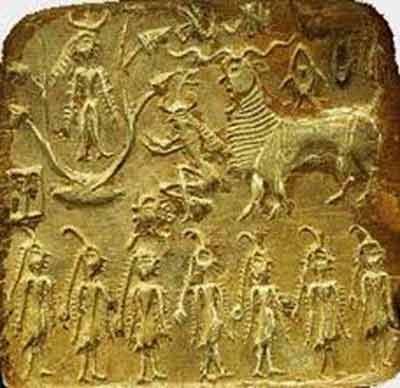
Indus Valley seal
Vikram Zutshi:
What have you found on the prehistory of the key Hindu goddess Durgā and her Tantric cult?
Asko Parpola:
An Indus seal excavated at Chanhu-daro depicts a bison bull about to mate with a human female lying on the ground. It apparently represents the 'sacred
marriage' between the sky-bull and earth-mother that has been a fundamental part of religion all over West Asia since Neolithic times. The greatest
religious festival in Mesopotamia in the third and second millennia BCE was the celebration of the 'sacred marriage' of Goddess Ishtar (who presided over
love and war) and her lover (who represented the spirit of fertility and grain). This 'sacred marriage' involved the death of the lover, lamented by the
participants of the festival. The Vedic aśvamedha, in which the sacrificed horse lies with the principal queen (representing Earth and the Vedic
goddess Vāc), probably goes back to a Harappan 'sacred marriage,' where the victim was buffalo instead of horse. The Vedic queen is called mahiṣī,
suggesting that her sacrificed mate was mahiṣa, buffalo bull. Such a variant of the 'sacred marriage' has survived in the buffalo sacrifice to
Goddess Durgā in Bengal and in southern India.
Vikram Zutshi:
There are some who claim the 'Aryan Invasion Theory' is mere speculation and that in fact migration happened out of India and not vice versa because there
is no evidence to prove it. Prof. Nicholas Kazanas and Shrikant Talageri are two such voices. How would you respond to them? Has the classical AIT been
modified in light of recent findings?
Asko Parpola:
Sanskrit and other Indo-Aryan languages belong to the Indo-European language family. The proto-language, from which which all branches of this linguistic
family descend, can to a large extent be reconstructed by comparing the similarities and differences between the different Indo-European languages. We know
from the reconstructed vocabulary of this proto-language that its speakers had ox-drawn wagons and carts, wheeled vehicles that are world-wide first
attested about 3600 BCE in the Tripolye culture of present-day Ukraine and Moldavia in south-eastern Europe. Due to climatic change, this most advanced
Copper Age culture dispersed about 3400 BCE in all directions: Tripolye-related people moved with their wheeled vehicles into areas where Indo-European
languages later appeared, most of them in Europe. Speakers of the Indo-Aryan languages can be traced back to Tripolye origins through a chain of
genetically related archaeological cultures of the Eurasian steppes. The reconstruction is confirmed by Proto-Indo-Aryan words borrowed into the last phase
of the Uralic protolanguage spoken around 2300-2000 BCE in the northeast of European Russia. Proto-Uralic *kekra 'circular thing, cycle' attests
to the transition from Proto-Indo-European *kwekwlos 'wheel, cycle' into Sanskrit cakra 'wheel, cycle'. These
archaeological and linguistic reconstructions are widely approved by archaeologists and linguists in many countries. There is no such internationally
acknowledged archaeological and linguistic evidence for the hypothesis that India was the original Indo-European homeland and that the Indo-European
languages spoken in Europe have come from India. I trust that eventually truth will prevail, as per the Sanskrit adage adopted by the state of India as its
logo: satyam eva jayate.
Jeffery D. Long
: Is it possible that the eventual transcription and reading of the Indus Valley script might complicate this picture? Might there have been trade between
the Indus Valley and the Eurasian steppe region? Indus sites have been found as far north as Shortugai, on the Afghan-Tajikistan border, and Indus seals in
the Bactria-Margiana Archaeological Complex, in what is now Turkmenistan. Might there have been influence in both directions? I am thinking of the
Gundestrup Cauldron, certainly a European (Celtic) artefact, but bearing a striking resemblance to the “Proto-Shiva” of some Indus Valley seals.
Asko Parpola:
Motifs of painted pottery and stamp seals testify to connections between the Greater Indus Valley, the Iranian Plateau and southern Central Asia
(Turkmenistan, Afghanistan) during the Early Harappan period (c. 5000-2600 BCE). During the Kot Diji phase (c. 2800-2600 BCE), the Early Harappans were in
contact with the Proto-Elamite culture (c. 3200-2600 BCE) that extended all over the Iranian plateau; they may have been inspired to create the Indus
script by seeing the Proto-Elamite script in use, although in any case they did not copy the actual script signs, but only adopted the idea of
logo-syllabic writing. The famous "Proto-Śiva" of the Mature Harappan seals appears to have an antecedent in the Proto-Elamite motif of "sitting bull".
Trade and cultural contacts with southern Central Asia continued in the Mature Harappan period, but the recorded Indus imports at Altyn-depe and Gonur in
Turkmenistan are limited to a few Indus seals and ivory sticks, while there is no evidence of direct Harappan influence upon the Eurasian steppes. The
Early Harappan inland contacts with the Iranian plateau were largely replaced in the Mature Harappan period by sea trade with the Gulf and Mesopotamia. The
Bactria and Margiana Archaeological Complex, however, greatly influenced the steppe world, but this seems to have happened mainly after the take-over of
the BMAC by Proto-Indo-Aryan speakers coming from the steppes around the 21st century BCE. The Gundestrup cauldron is some 1500 years later than the Indus
Civilization, and Denmark is far removed from the Indus Valley without any clear intermediating links. I consider its similarity with the Harappan
"Proto-Śiva" a pure coincidence, comparable to the resemblance between the Easter Island script and the Indus script, removed from each other by the
greatest possible space and some 3500 years.
Debashish Banerji
: Adding to Jeffery’s question, you had once suggested a period of bilingualism and cultural exchange between the Indus Valley populations and the BMAC
culture. Since cultural change does not necessarily depend on physical migrations, how compelling do you find the invasion theory and the migration theory?
What kinds of populations were involved? Can one draw on genetic studies to discover significant temporal shifts in the gene pool?
Asko Parpola:
While cultural change does not necessarily depend on physical migrations, introduction of bilingualism and language shift does. I do not think the
Indo-Aryan language could have been introduced to Central and South Asia without the immigration of pastoralist people from the steppes speaking this
language. In my book I have concentrated on correlating linguistic and archaeological reconstructions of the past and ignored genetic evidence, because to
my understanding dating genetic migrations has been very problematic.
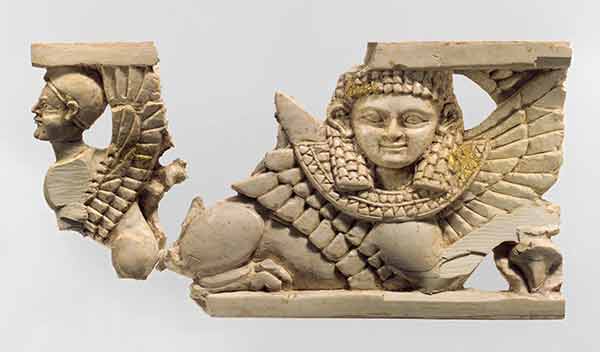
Openwork furniture plaque with two sphinxes, Assyria, 1365-609 BC @ Met Museum
Vikram Zutshi:
Who were the Mittani people of Syria? What are their links to Vedic civilization?
Asko Parpola:
The kingdom of Mittani or Mitanni in present-day Syria was one of the three great powers of West Asia around 1500-1300 BCE. The other two were the Hittites
of Anatolia (the Asiatic part of present-day Turkey) and the Egyptians. The people of Mittani/Mitanni spoke Hurrian, a language different from that of
their rulers, who had Indo-Aryan names, and whose ancestors apparently had introduced horse-drawn war-chariots into West Asia. A Mitannian called Kikkuli
wrote for the Hittites a handbook for training chariot-horses, and it contains technical terms of Indo-Aryan origin. The Proto-Indo-Aryan nobility that
took over the power in Syria had come via northern Iran from the "Bactria and Margiana Archaeological Complex" (BMAC), a Bronze Age culture discovered in
the 1970s in southern Turkmenistan and northern Afghanistan. The BMAC had gone through a similar take-over of power by Proto-Indo-Aryan speakers coming
from the steppes of Kazakhstan and Russia, where the earliest horse-drawn chariots have been found (around 2100 BCE at Sintashta and Arkaim in the southern
Urals). The earlier mentioned two waves of Indo-Aryan speakers to South Asia also came from the BMAC.
Vikram Zutshi:
Tell us about the early Iranians and 'left handed' Tantrism.
Asko Parpola:
While the Proto-Indo-Aryans left the "Aryan homeland" in the Pontic steppes north of the Black Sea around 2300 BCE by pushing further east to the Asiatic
steppes, the Proto-Iranian speakers stayed in south-eastern Europe until they adopted horse-riding around 1500 BCE. Almost immediately the first East
Iranians moved to southern Central Asia, where they succeeded the BMAC, taking over some BMAC traditions like fortified settlements. These East Iranian
speakers are the Dāsas, whose fortresses were stormed by the Rigvedic Aryans on their way to the Indus Valley. The Dāsas, whose ethnic name is derived from
the East Iranian word dasa (later daha) meaning 'man, hero', also came to South Asia, adopting there the Indo-Aryan language, but
bringing with them some of their gods - among them Śambara, Yama (Avestan Yima) and 'the master of Fire' Ātar-iśvan (whose name changed into Mātariśvan in
the Veda). The use of an enemy's skull as a drinking vessel, and the promiscuous orgies before a war-expedition may also be Dāsa heritage in Śākta
Tantrism.
Debashish Banerji:
What do you see as the history of the similarities between the Vedic and Greek gods? Some of the Greek mythologies were related to initiatic mystery
cults and oracles. Is there a possibility of similar practices related to the Vedic gods?
Asko Parpola:
In my book, I am discussing at length the connection of the Aśvins (and their assumed doubles Mitra and Varuṇa) with their counterparts in the Greek
religion, the Dioskouroi (Kastor and Polydeukes); these seem to be originally Proto-Indo-Aryan deities that came into being when the horse-drawn chariot
was invented around 2100 BCE in the southern Urals, and spread with the chariot also to the Balts. To Greece they came with the Dorians, apparently only
after chariot-driving was largely replaced by horse-riding, which started taking place around 1500 BCE. The initiatic mystery cults of Greece go back to
West Asian Goddess cults, connected with agricultural fertility rites of hoary age (at least 6000 BCE), while their Vedic counterparts also go back to West
Asia, but via the Indus Civilization.
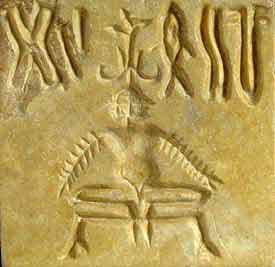
Yogi, Indus Valley seal
Vikram Zutshi:
What is the Dilmun, Magan and Meluhha?
Asko Parpola:
Dilmun, Magan and Meluhha are the three foreign countries with which the Mesopotamians had relations of maritime trade, the most far-off country Meluhha
denoting the Greater Indus Valley and the Harappan civilization. Among Meluhhan imports was ivory, which in the third millennium did not yet come to
Mesopotamia from Africa. The Akkadian kings penetrated far into the Iranian plateau in their eastward war expeditions, but never reached Meluhha. One
Meluhhan king, however, participated in the world-wide rebellion of 17 kings against the Akkadian king Narām-Sīn (ruled 2254-2218 BCE). Because the
cuneiform tablet telling about this event is broken, we know only the last two syllables of his name. This tantalizing piece of information is the only
record we currently have of the political history of the Indus Civilization.
Vikram Zutshi:
Tell us about the Atharva Veda and the Vrātyas.
Asko Parpola:
The language and religion of the Atharvaveda differs clearly from that of the Rigveda, although by the time of its composition and recording, the Rigvedic
poetry had already influenced the Atharvavedic tradition. The Atharvaveda contains both "white magic" and "black magic", spells to cure illnesses, to
fulfil all sorts of wishes, and to crush enemies. The Atharvavedic tradition, the lore of the royal purohita, is connected with royal rituals and
with archaic rites of warring bands of young men called vrātya. These have an Indo-European background but contain elements inherited by the
Atharvavedic tradition from the Indus Civilization.
Debashish Banerji:
The large number of sites on the banks of the dry Ghaggar-Hakra river, popularly called Saraswati, has led to many scholars displacing the center of the
Indus civilization to the Saraswati and proposing the nomenclature Sindhu-Saraswati civilization. What is your view on this?
Asko Parpola:
In view of the large number of sites on the Saraswati river, one may of course propose to call the Mature Harappan culture Sindhu-Saraswati Civilization.
This name has been proposed by Indian scholars, who understandably want to emphasize that this civilization existed also in present-day India, not only in
present-day Pakistan, the area of the Indus (Sindhu) river. Indian scholars have recently started claiming that the Indus Civilization originated in India
and then spread to Pakistan, and not vice versa, as has been usually thought so far. For the time being, I prefer the traditional view, referring
particularly to Akinori Uesugi's paper "Development of the inter-regional interaction system in the Indus Valley and beyond: A hypothetical view towards
the formation of an urban society" (2011).
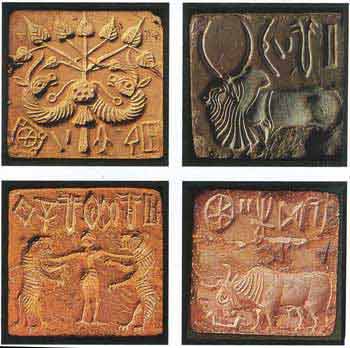
Indus Valley seal
Vikram Zutshi:
Tell us about Megalithic culture and the Great Epics.
Asko Parpola:
A new wave of Aryan horsemen came to South Asia from the west around 800 BCE, bringing with them the so-called Megalithic culture. They seem to have
penetrated first to the Vidarbha region and, adopting the local Black-and-Red Ware as their pottery, spread to peninsular India and Sri Lanka during the
following centuries. The Megalithic people may originally have spoken a West Iranian language, but they soon adopted Indo-Aryan and in South India local
Dravidian languages. The Iranian-like polyandric marriage system of the Pāṇḍavas (unknown to, and condemned by, the Kauravas), and the birth myth of Pāṇḍu
implying that the Pāṇḍavas were white-skinned people, are hints suggesting that the Pāṇḍavas of the Mahābhārata belonged to these Megalithic immigrants.
Their appellation Pāṇḍava is related to that of the early Pāṇḍya kings of Tamil Nadu, and to Paṇḍu-Vāsudeva among the early rulers of Sri Lanka.
Debashish Banerji:
While the original hypothesis for the demise of the Indus Civilization was the Aryan Invasion (later replaced by Aryan Migration) many scholars today think
of this disappearance as caused by climatic reasons having to do with flooding or drying up of water sources. What is your view on this?
Asko Parpola:
It seems likely that climatic changes were the main reason for the disappearance of the Indus Civilization, but it is very probable that this "systems
collapse" had multiple causes.

A sellection of seals found in Indus-Harappan region
Vikram Zutshi:
What do the numerous seals found in the Indus valley tell us about this fascinating culture?
Asko Parpola:
For their inscriptions see my reply to your question 3 above. The iconographic motifs on the seals include superb creations of miniature art. Constituting
one of the most important sources of Harappan religion, they witness the Indus origin of some fundamental constituents of South Asian folk religion, the
worship of sacred trees, particularly fig trees, and of sacred animals.
Debashish Banerji:
Some scholars have seen the roots of yoga and puja in some of the Indus Valley seals. Do you have any insights on this? On another issue, Mahadevan has
posited that the objects in front of the “unicorn” in the unicorn seals is a Soma filter. How do you relate to this seal?
Asko Parpola:
So far the evidence for Harappan origin of yoga has mainly consisted of the assumed "yoga-āsana" of the "Proto-Śiva". However, this seating posture appears
to have been adopted from Proto-Elamite iconography, though this does preclude that possibility that in the Indus Valley this posture was connected with
yoga. In my book, I am suggesting new arguments for Harappan origin of yoga, based on some cosmic ideas connected with Dravidian astronomical terms
(especially the name of the Pole Star) readable in the Indus script.
The non-Vedic origin of pūjā is likely on the basis of textual and ethnographic evidence, as well as the Dravidian etymology of the word pūjā (from pūcu 'to smear') proposed by Hermann Gundert in 1869.
The Soma cult was introduced to India by the Rigvedic tradition long after the disappearance of the Indus Civilization. I see a connection between the
cultic object in front of the Indus "unicorn" and its counterpart in the painted pottery of the Kulli culture of southern Baluchistan; in the Kulli
pottery, a humped bull is tethered to this object, while in the painted pottery of Nausharo dated to the transitional period between the Early and Mature
Harappan phases (c. 2600-2500 BCE), the zebu bull is tethered to different trees. Could the cultic object of the "unicorn" represent some sort of
sacrificial stake? Vedic animal sacrifices required tying the victim to a yūpa.
Vikram Zutshi:
What is your opinion on the state of scholarship and education in India today?
Asko Parpola:
India has always had brilliant scholars. During my lifetime, India has produced so many competent scientists; earlier they moved abroad as their
opportunities of research and employment were not so good at home; but in recent years the situation in India has improved, and some are returning from
abroad. Education has remarkable achievements for instance in Kerala, which can now boast with 100% literacy. I am worried, however, about repeated recent
political attempts to favour certain views of the past and to curb the freedom of expressing different opinions. Such attacks are directed both against
renowned Indian historians labelled "Marxists" and against foreign specialists of Indology who have devoted their lives to disinterested study of India's
past. Professor Wendy Doniger's excellent book on Hinduism, for example, was successfully demanded to be pulped, although it did not contain anything
untruthful. It is not her fault that the history of Hinduism includes things that some Hindus today do not like, but which must be known in order to have a
complete and balanced view of Hinduism. Indian culture and the Hindu religion belong as important and integral constituents to the common heritage of
mankind, and Indian politicians and nationalists should not try to monopolize and censor their study. Also alarming is the related trend to increase the
teaching of Hindi and Sanskrit in schools at the expense of foreign languages including English. The study of Sanskrit and its classical literature does
need governmental support, but this positive development should not be exaggerated so that it will lead to the neglect of other important topics.